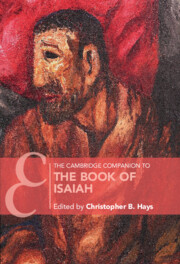Book contents
- The Cambridge Companion to the Book of Isaiah
- Frontispiece
- Cambridge Companions to Religion
- The Cambridge Companion to the Book of Isaiah
- Copyright page
- Contents
- Notes on Contributors
- Acknowledgments
- Timeline of Events Related to the Book of Isaiah
- Abbreviations
- Maps
- 1 Introduction
- Part I The Book of Isaiah Through History
- 2 The Book of Isaiah in the Neo-Assyrian Period
- 3 The Book of Isaiah and the Neo-Babylonian Period
- 4 The Book of Isaiah in the Persian Period
- 5 The Book of Isaiah at Qumran
- 6 Early Versions of Isaiah as Translations and Interpretations
- 7 The Formation of the Book of Isaiah
- Part II Isaiah in Its Cultural World
- Part III Isaiah as Literature
- Part IV Afterlives of the Book of Isaiah
- Scripture Index
- Other Texts Index
- Subject Index
- Cambridge Companions to Religion ()
- References
5 - The Book of Isaiah at Qumran
from Part I - The Book of Isaiah Through History
Published online by Cambridge University Press: 08 November 2024
- The Cambridge Companion to the Book of Isaiah
- Frontispiece
- Cambridge Companions to Religion
- The Cambridge Companion to the Book of Isaiah
- Copyright page
- Contents
- Notes on Contributors
- Acknowledgments
- Timeline of Events Related to the Book of Isaiah
- Abbreviations
- Maps
- 1 Introduction
- Part I The Book of Isaiah Through History
- 2 The Book of Isaiah in the Neo-Assyrian Period
- 3 The Book of Isaiah and the Neo-Babylonian Period
- 4 The Book of Isaiah in the Persian Period
- 5 The Book of Isaiah at Qumran
- 6 Early Versions of Isaiah as Translations and Interpretations
- 7 The Formation of the Book of Isaiah
- Part II Isaiah in Its Cultural World
- Part III Isaiah as Literature
- Part IV Afterlives of the Book of Isaiah
- Scripture Index
- Other Texts Index
- Subject Index
- Cambridge Companions to Religion ()
- References
Summary
In “The Book of Isaiah at Qumran,” Jesper Høgenhaven offers a concise overview of the texts related to Isaiah that were discovered among the Dead Sea Scrolls. The book’s importance for the Qumran community is attested not only by the large number of copies that survived, but also by various other genres of sectarian literature that drew from and reflected on the book, including the pesher commentaries and even the Community Rule (1QS). The Great Isaiah Scroll (1QIsaa) is the longest biblical scroll found at Qumran. It is an important witness for reconstructing the oldest text of the book, and also subtly reflects some of the earliest interpretive decisions about it.
Keywords
- Type
- Chapter
- Information
- The Cambridge Companion to the Book of Isaiah , pp. 68 - 80Publisher: Cambridge University PressPrint publication year: 2024

